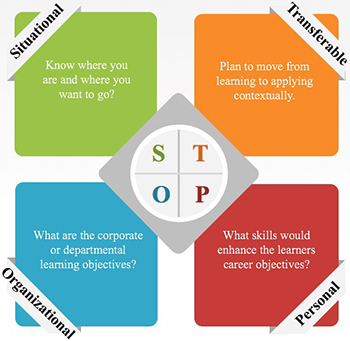
In the First of a Five Part Series, Managing Director, Peter Methot writes, 'S.T.O.P. to Achieve Return on Learning (ROL)'
Learning and development must be viewed as more than a supplemental activity and, instead, become a strategic partner in organizations. At Rutgers Business School Executive Education (RBSEE), we created a simple acronym to strategize how, when, and (most importantly) why to build learning programs with impact. Here, in this first post of a 5-part series, we will introduce the problem and present the four-letter acronym that aims to prevent costly missteps. Over the remaining posts of this series, we will examine each element, linking specific questions and ideas to each part to assign business purpose to each learning engagement.
Too often we meet with clients who say: “I was told that we need a program for our high potentials in the area of ______ (blank) and want to know what Rutgers can provide.” Before we can proceed, however, there are a few questions that need to be addressed. Like any good educational partner, we want to pinpoint the why and the what. Why are the leaders asking for a program—does data exist to support this need? Is there a new or existing corporate strategy that requires additional skills or knowledge or is it being suggested for another reason with less tangible associated outcomes? Next, we focus on deciphering what business needle they are trying to move (which is not necessarily what the client is directly asking for). Many times the presenting problem is simply a knee jerk reaction to some internal or external force that casts a light on gaps without measurement of magnitude or strategy.

We have adopted the acronym S.T.O.P.: Situational, Transferable, Organizational, Personal. To be clear, this is not intended to direct individuals to stop learning in an organization; rather it signals the importance of pausing to evaluate the following 4 dimensions before jumping into a training mandate.
- “Situational” captures the context—business unit, department and/or larger organization—in which the training occurs to define where you are now and where you want to go. It is critical to understand the path and the players needed to arrive at the desired destination.
- “Transferable” refers to the learning plan coupled with on-the-job applicability. How will participants absorb, retain, and apply knowledge to their work responsibilities. Knowledge is important, but transferring it to drive organizational objectives is a complex challenge.
- “Organizational” refers to the organizational results that will quantify the training as successful. Use the end goals to outline a path that allows for building backwards. Upon program completion, the data will evidence whether the program was successful.
- “Personal” captures the alignment between personal and organizational objectives. What knowledge and skills are important for the employee to advance? Further, explore the connective tissue between individual knowledge gain and the progression towards organizational advancement.
Unequivocally, all four of these organizational training elements are intertwined when achieving a strategic partnership; yet, clients often emphasize delivering on a request at the expense of this invaluable process. While this rubric may appear relevant specifically to learning and development professionals, it can also be applied from a more strategic leadership perspective and trickle down to an individual learner. In the forthcoming blog posts, we will dissect and explore each area of discovery and planning, and apply them to various stakeholders to flesh out the model.
Press: For all media inquiries see our Media Kit


